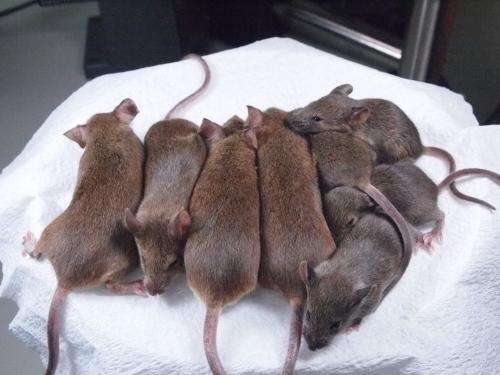Researchers succeed in making generations of mouse clones

Using the technique that created Dolly the sheep, researchers from the RIKEN Center for Developmental Biology in Kobe, Japan have identified a way to produce healthy mouse clones that live a normal lifespan and can be sequentially cloned indefinitely.
Their study is published today in the journal Cell Stem Cell.
In an experiment that started in 2005, the team led by Dr. Teruhiko Wakayama has used a technique called somatic cell nuclear transfer (SNCT) to produce 581 clones of one original 'donor' mouse, through 25 consecutive rounds of cloning.
SNCT is a widely used cloning technique whereby a cell nucleus containing the genetic information of the individual to be cloned is inserted into a living egg that has had its own nucleus removed. It has been used successfully in laboratory animals as well as farm animals.
However, until now, scientists hadn't been able to overcome the limitations of SNCT that resulted in low success rates and restricted the number of times mammals could be recloned. Attempts at recloning cats, pigs and mice more than two to six times had failed.
"One possible explanation for this limit on the number of recloning attempts is an accumulation of genetic or epigenetic abnormalities over successive generations" explains Dr. Wakayama.
To prevent possible epigenetic changes, or modifications to DNA function that do not involve a change in the DNA itself, Wakayama and his team added trichostatin, a histone deacetylase inhibitor, to the cell culture medium. Using this technique, they increased cloning efficiency by up to 6-fold.
By improving each step of the SCNT procedure, they were able to clone the mice repeatedly 25 times without seeing a reduction in the success rate. The 581 healthy mice obtained in this way were all fertile, they gave birth to healthy pups and lived a normal lifespan of about two years, similar to normally conceived mice.
"Our results show that there were no accumulations of epigenetic or genetic abnormalities in the mice, even after repeated cloning," conclude the authors.
Dr. Wakayama adds, "This technique could be very useful for the large-scale production of superior-quality animals, for farming or conservation purposes."
Dr. Wakayama's work made the news in 2008 when his team created clones from the bodies of mice that had been frozen for 16 years, using SNCT.
More information: Sayaka Wakayama, Takashi Kohda, Haruko Obokata, Mikiko Tokoro, Chong Li, Yukari Terashita, Eiji Mizutani, Van Thuan Nguyen, Satoshi Kishigami, Fumitoshi Ishino and Teruhiko Wakayama "Successful serial cloning in the mouse over multiple generations." Cell Stem Cell, 2013, doi: org/10.1016/j.stem.2013.01.005
Journal information: Cell Stem Cell
Provided by RIKEN

















